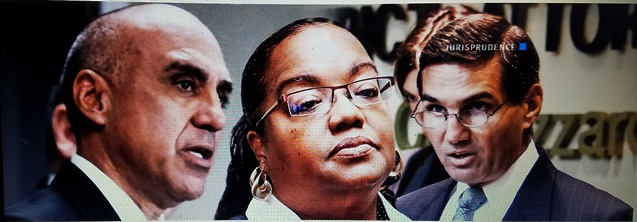
Wayne County Prosecutor Kym Worthy (center) with San Bernadino County DA Michael Ramos (l) and Orleans Parish DA Leon Cannizzaro (r)
When convictions are clearly wrong, these prosecutors don’t just hinder justice—they actively work against it.
 Jan 10, 2018 Excerpt from full story by Lara Bazelon in Slate Magazine. She also discusses California’s San Bernardino County District Attorney Michael Ramos, and Louisiana’s Orleans Parish District Attorney Leon Cannizzaro, but this excerpt focuses on Worthy.
Jan 10, 2018 Excerpt from full story by Lara Bazelon in Slate Magazine. She also discusses California’s San Bernardino County District Attorney Michael Ramos, and Louisiana’s Orleans Parish District Attorney Leon Cannizzaro, but this excerpt focuses on Worthy.

Davontae Sanford (center) beams as his family including (l to r) nephew, sisters, mother Taminko Sanford-Tilmon, stepfather the late Jeremaine TIlmon, and Apostle W. J. RIdeout III applaud his release. at press conference June 9, 2016/Photo by Diane Bukowski
Davontae Sanford was 14 years old when he confessed to murdering four people in a drug house on Detroit’s East Side. Left alone with detectives in a late-night interrogation, Sanford says he broke down after being told he could go home if he gave them “something.” On the advice of a lawyer whose license was later suspended for misconduct, Sanford pleaded guilty in the middle of his March 2008 trial and received a sentence of 39 to 92 years in prison.
Sixteen days after Sanford was sentenced, a hit man named Vincent Smothers told the police he had carried out 12 contract killings, including the four Sanford had pleaded guilty to committing. Smothers explained that he’d worked with an accomplice, Ernest Davis, and he provided a wealth of corroborating details to back up his account. Smothers told police where they could find one of the weapons used in the murders; the gun was recovered and ballistics matched it to the crime scene. He also told the police he had used a different gun in several of the other murders, which ballistics tests confirmed. Once Smothers’ confession was corroborated, it was clear Sanford was innocent. Smothers made this point explicitly in an 2015 affidavit, emphasizing that Sanford hadn’t been involved in the crimes “in any way.”
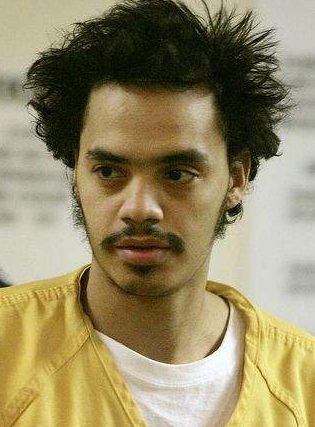
Vincent Smothers appears in court March 25, 2012.
But Smothers and Davis were never charged. Neither was Leroy Payne, the man Smothers alleged had paid him to commit the murders. (Through his attorney, Payne has denied any involvement.) Instead, Smothers pleaded guilty to the other eight killings. Davis, who was never prosecuted, was convicted of an unrelated felony in 2013 and could be released from prison as early as July. Payne, who remains a free man, left Detroit in 2016. His whereabouts are unknown.
Davontae Sanford, meanwhile, remained behind bars, locked up for crimes he very clearly didn’t commit.
Police failed to turn over all the relevant information in Smothers’ confession to Sanford’s legal team, as the law required them to do. When that information was leaked in 2009, Sanford’s attorneys sought to reverse his conviction on the basis of actual innocence. Wayne County Prosecutor Kym Worthy fought back, opposing the motion all the way to the Michigan Supreme Court. In 2014, the court sided with Worthy, ruling that actual innocence was not a valid reason to withdraw a guilty plea. Sanford would remain in prison for another two years.
In an adversarial legal system, it’s natural to presume that prosecutors and defense attorneys are driven by the same goal: to win. They aren’t. In Berger v. United States, decided in 1935, the Supreme Court famously declared that the prosecution’s ultimate goal “is not that it shall win a case, but that justice shall be done.” A prosecutor, the court wrote, “is in a peculiar and very definite sense the servant of the law, the twofold aim of which is that guilt shall not escape or innocence suffer.”
Some prosecutors—the most powerful actors in the criminal justice system—refuse to correct life-altering errors.
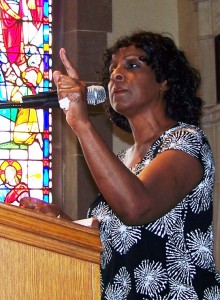
Maryanne Godboldo speaks at church rally after her initial release. She defended her daughter from illegal kidnapping by Child Protective Services and police in 2011 and became world renowned for her courage. But Kym Worthy brought multiple criminal charges against her, which were twice thrown out by District and Circuit Court Judges who called the seizure illegal. But Worthy continued to appeal. Eventually Godboldo sustained a brain aneurysm on the eve of her third criminal trial, which caused her death last year.
Embracing this “twofold aim” is at the core of a prosecutor’s work. The government brings cases it believes are supported by proof beyond a reasonable doubt. A victory at trial proves them right. But if new evidence is uncovered showing the conviction was error-ridden to the point of unreliability, the imperative that “justice shall be done” requires prosecutors to admit they were wrong. This responsibility exists even if a defendant may be guilty—if, for example, crucial evidence was obtained by illegal means. The moral imperative underpinning this precept, though, is brought into sharpest relief when it appears the defendant is actually innocent.
Many prosecutors accept this responsibility and, when proven wrong, ask the judge to dismiss a case or settle by way of a plea bargain. But too many do not. Indeed, there is a class of prosecutors that might fairly be called innocence deniers.
These prosecutors do not “do justice” as the Supreme Court defines it. Instead, they delay justice and in some cases actively work against it. When a prisoner is exonerated by a lower court, these prosecutors double and triple down, filing appeal after appeal. Or they indict and prosecute the exoneree all over again, sometimes under a wildly different theory at the expense of time and resources that should be used to pursue the crime’s actual perpetrator. They may also threaten endless legal challenges to wring “no contest” pleas from innocent prisoners in exchange for time-served sentences. The prisoners, desperate to be free, accept these Faustian bargains, which brand them convicts for life and allow prosecutors to proclaim their guilt and the state to deny them compensation. Some prosecutors are so committed to adhering to the original mistake that they fail to prosecute the actual perpetrators, even when there is evidence to convict them.
Innocence deniers are a diverse group: male and female, young and old, white and people of color. They are Democrats and Republicans from red, blue, and purple states. What they have in common is their insistence—in the face of all evidence to the contrary—that wrongfully convicted people are in fact guilty.
Simply opposing an exoneration effort does not make a prosecutor an innocence denier. Some exoneration claims are bogus and others are murky, requiring rigorous legal testing to be proven conclusively. Increasingly, conscientious prosecutors are working collaboratively with defense attorneys to reinvestigate innocence claims, keeping an open mind and doing the right thing in the end. Innocence-denying prosecutors are different. The cases collected here are extreme, either because the prosecutor in question has a pattern of reflexively denying innocence or because, even in a single case, the evidence of innocence is so manifest as to make the fight against it profoundly misguided.
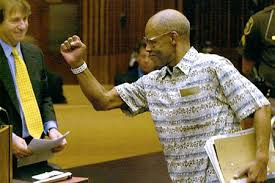
Eddie Joe Lloyd at hearing in which he was exonerated from a rape/murder of a teenage girl. Barry Scheck of the Innocence Project is at the left.
In the past quarter-century, the work of dogged attorneys and advances in forensic science have exonerated more than 2,150 men and women, 161 of those from death row. The Innocence Project, a New York–based nonprofit founded by Barry Scheck and Peter Neufeld in 1992, has freed more than 200 people and spurred the creation of numerous smaller organizations around the country devoted to the same mission. (From 2012–2015, I was the director of the Loyola Law School Project for the Innocent in Los Angeles.) By some estimates there are tens of thousands more wrongfully convicted prisoners languishing behind bars. Nevertheless, some prosecutors—the most powerful actors in the criminal justice system—refuse to correct life-altering errors. (You can read more about 17 such cases here.) If we are committed to fostering a justice system that is truly just, it is imperative to call out these innocence deniers and hold them to account.
Kym Worthy, a Democrat and the first black woman or man to serve as Wayne County’s lead prosecutor, first took office in 2004 and coasted to re-election for a fourth term in November 2016. The former circuit court judge has a national reputation as a trailblazing progressive—last April, Essence named her to its “Woke 100 List” to honor her efforts “to achieve equality for people of color.” Worthy’s office, however, has repeatedly refused to admit error in cases like Davontae Sanford’s, where there is compelling evidence of actual innocence.
The lid was covered with bloody fingerprints, which had never been tested.
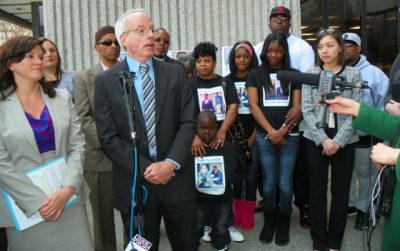
Attorneys Megan Crane and David Moran of two Innocence Clinics announce filing of motion for relief from judgment for Davontae Sanford May 4, 2015, as family members listen.
The Michigan Supreme Court’s adverse ruling in 2014 wasn’t the end of the line for Sanford. The court ruled against him on technical grounds and noted that there was nothing to prevent his legal team from filing a post-conviction motion for relief from the judgment, rather than making a direct challenge to his guilty plea.
In 2015, attorneys for Sanford, who is black, did just that, and the Michigan State Police began to re-investigate the case. One year later, the police issued a 117-page report detailing compelling evidence that Smothers and Davis were guilty; that Sanford was innocent; and that Detroit’s then deputy police chief, James Tolbert, had lied to convict Sanford. It was at that point, nine years into Sanford’s incarceration, that Worthy finally agreed to his release—but only on account of Tolbert’s misconduct. She continues to insist that Sanford is guilty, pointing to his discredited confession. The state police recommended bringing perjury charges against Tolbert and murder charges against Smothers and Davis. Worthy declined in all three cases.
In July 2017 Sanford filed a civil suit under Michigan’s Wrongful Imprisonment Compensation Act, and only four months later the state attorney general conceded that Sanford was innocent, had been wrongfully convicted, and was entitled to compensation, but noted that Worthy’s office “has been consulted and disagrees.” Julie Hurwitz, one of the attorneys who represents Sanford, told me she was “surprised” that the state acquiesced so readily but that given the crush of media attention the case has received, “the attorney general’s office probably knew that fighting this would be a political bombshell.” On Dec. 21, a judge awarded Sanford $408,356.16.
In reference to her office’s handling of Sanford’s case, Worthy has said, “I don’t know what we could have done differently.”
David Moran, director of the Michigan Innocence Clinic, has tangled with Worthy in a half-dozen cases in which he says her office has fought his efforts to free clients. Moran, who helped lead the fight to exonerate Sanford alongside the Center on Wrongful Convictions of Youth at the Northwestern Pritzker School of Law, also battled the Wayne County prosecutor in the case of Lamarr Monson, who was convicted in the 1996 murder of a 12-year-old girl and sentenced to 30 to 50 years in prison. Monson, who like Sanford is black, claimed he’d been tricked into signing a false confession stating that he’d stabbed the victim to death.
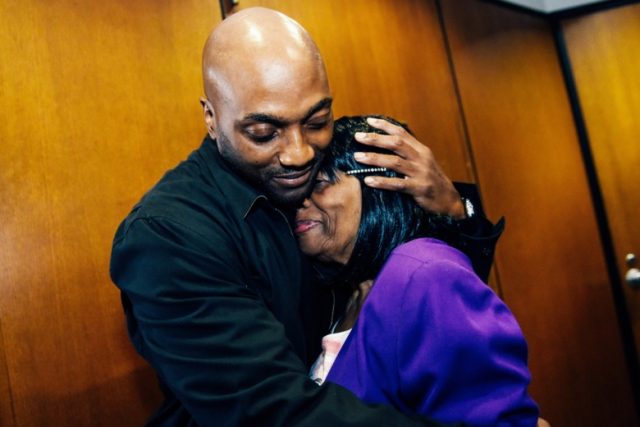
Lamarr Monson, hugs his mother in 2017 after all charges were dismissed against him in the 1996 slaying of 12-year-old Detroiter Christina Brown. Clarence Tabb/The Detroit News
Nearly 20 years after the murder in question, Moran and his students examined the object that the medical examiner had identified as the likely murder weapon: a ceramic toilet lid used to bludgeon the victim over the head. The lid was covered with bloody fingerprints, which had never been tested. The Michigan State Police found that all the fingerprints matched a man named Robert Lewis, who was living in the same building as the victim at the time of the murder.
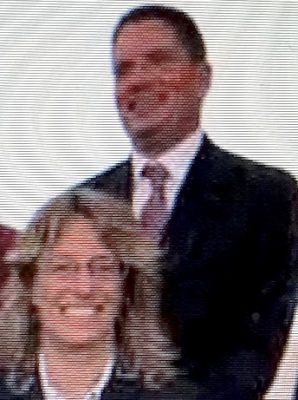
Wayne Co. AP’s David McCreedy (top), Valerie Newman (bottom) at forum. Newman switched sides from defense to prosecution.
During a four-month-long evidentiary hearing in late 2016, the Michigan Innocence Clinic presented the fingerprint evidence and called Lewis’ then live-in girlfriend Shellena Bentley as a witness. Bentley testified that Lewis came back to her apartment on the night of the murder “frantic” with “blood on him; it was dripping off his fingernails.” David McCreedy, the assistant prosecutor assigned by Worthy to fight the case, didn’t find this account convincing. He explained that Lewis might have wandered by the apartment while the building manager was on the phone with 911, then moved the toilet tank out of the way to help the paramedics. Moran told me that he responded: “There might be 12 gullible citizens that would buy that, but that’s why we need a new trial: to see if the state can find them.”
The judge granted Monson a new trial; he was subsequently released on bond. Worthy, who agreed to be interviewed about Monson’s case—she declined to comment on Devontae Sanford’s, citing ongoing litigation—told me her office sought to delay the retrial so it could conduct an additional investigation. Two homicide investigators were dispatched to interview Lewis, who denied committing the murder. “His statements were consistent with the evidence that was available in the case,” Worthy says, despite Lewis’ fingerprints being all over the bloody toilet lid, including around the edges, Moran says, suggesting that he gripped it. (Worthy’s deputies do not concede that the toilet tank was the murder weapon; one told me that the victim’s “head could have been slammed against the back of the bathtub,” causing the fatal injury.)
In August, a few weeks before Monson’s retrial, the prosecution dismissed the case. In a public statement, Worthy said Monson had lived with the 12-year-old victim, that he’d had sex with her, and that he’d demanded that she sell drugs for him. The decision to drop the charges against Monson, Worthy said, was not due to a belief in his innocence, but instead due to “the destruction of evidence and the possible coercive conduct of the then-homicide inspector in obtaining statements from the defendant.” Her office, she said, would not be charging Robert Lewis with the murder. Lewis is still free.
Moran says Worthy’s charge that Monson had sex with the 12-year-old victim is “false and disturbing,” adding that “it is unethical for a prosecutor, upon dismissing charges against a defendant, to then publicly defame that defendant.” His client, he says, emphatically denies that any sexual contact occurred. Asked to respond, Worthy cited Monson’s statements to the police—the same statements she has admitted were possibly coerced in a manner that “supports Monson’s defense of a false confession.”
Worthy did tell me, however, that her office is in the process of launching a standalone unit to review possible wrongful convictions. That group will be headed up by Valerie Newman, a longtime attorney at the Michigan State Appellate Defender Office, which represented Sanford before the Michigan Innocence Clinic took over his case. Worthy says that project has been in the works for some time, but became possible only after she obtained funding from the Wayne County Commission.
Moran reacted to the news with cautious optimism, saying, “I hope that the Wayne County Prosecutor’s Office is changing its attitude and will seriously consider these cases.” He has cases lined up to present to the unit as soon as it opens for business.
 Lara Bazelon is an associate professor at the University of San Francisco School of Law and a contributing writer for Slate. Her book Rectify: A Story of Healing and Redemption After Wrongful Conviction will be published in the fall.
Lara Bazelon is an associate professor at the University of San Francisco School of Law and a contributing writer for Slate. Her book Rectify: A Story of Healing and Redemption After Wrongful Conviction will be published in the fall.
The full story is at https://slate.com/news-and-politics/2018/01/innocence-deniers-prosecutors-who-have-refused-to-admit-wrongful-convictions.html.




